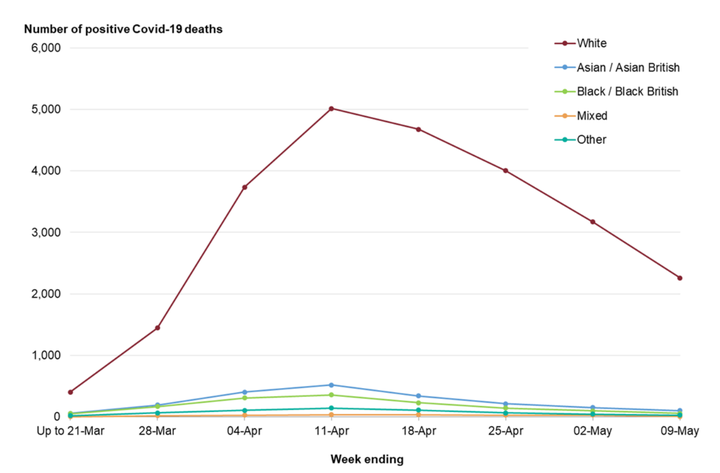Coronavirus has changed everything. Make sense of it all with the Waugh Zone, our evening politics briefing. Sign up now.
Black, Asian and minority ethnic (BAME) people are more likely to die of coronavirus than their white counterparts, an official report has found.
Public Health England (PHE) research suggested people of Bangladeshi ethnicity were twice as likely to die as those who are white British.
People of Chinese, Indian, Pakistani, other Asian, Caribbean and other Black ethnicities had a 10% to 50% higher risk of death than those of white British ethnicity.
The findings are adjusted for age, sex, deprivation and region, meaning that even with disparities in those factors between ethnic groups there is still a difference in mortality rate.
But PHE stressed that the research did not account for the effect of occupation, existing conditions (comorbidities) or obesity.
“These are important factors because they are associated with the risk of acquiring Covid-19, the risk of dying, or both,” the report said.
“Other evidence has shown that when comorbidities are included, the difference in risk of death among hospitalised patients is greatly reduced.”
The report was published with ministers under pressure amid reports it could be delayed due to the Black Lives Matter protests against racism in the United States and solidarity movements around the world.

The report also found that those at higher risk included:
- Those over 80, who were 70 times more likely to die than under-40s
- Men
- People in the most deprived areas, who were more than twice as likely to die as those from the least deprived areas
People in deprived areas “may” be more at risk of infection because they live closer together, or because they live in places that contain a higher proportion of workers in jobs more likely to be exposed to the virus, the report said.
But “further investigation” is needed on the role of underlying health conditions in people from deprived areas, who are more likely to die even after adjusting for ethnicity, the report said.
There was also a “particularly high increase” in all-cause deaths – that is deaths in the population for any reason – during the Covid-19 pandemic among:
- Those born outside UK and Ireland – with the biggest increases coming in people from central and western Africa, the Caribbean, south east Asia, the Middle East
and south and eastern Africa - Those in caring occupations, including social care and nursing auxiliaries and assistants
- Taxi drivers and chauffeurs
- Security guards and related occupations
- Care homes
Furthermore, there were 54 men and 13 women diagnosed with Covid-19 with no fixed abode, who are likely to be rough sleepers.
PHE estimated that this represents 2% and 1.5% of the known
population of women and men who experienced rough sleeping in 2019, suggesting a much higher infection rate in rough sleepers compared to the general population.
Health secretary Matt Hancock said equalities minister Kemi Badenoch would be “leading” on work with PHE to “further understand” impact of Covid-19.
In the Commons, he said: “People are understandably angry about injustices. And as health secretary I feel a deep responsibly because this pandemic has exposed huge disparities in the health of our nation.
“It is very clear some people are significantly more vulnerable to Covid-19.
“This is something I am determined to understand in full and take acton to address.”
The analysis did not take into account jobs, an “important shortcoming” given that some key occupations have a higher proportion of workers from BAME groups.
But the higher BAME death rates were the “opposite of what is seen in previous years”, when deaths were lower in Asian and Black ethnic groups compared to white groups.
The report said BAME people were “likely” to be at higher risk of infection because they are more likely to live in urban or deprived areas, overcrowded households, or have jobs that expose them to have a higher risk.
BAME groups are also more likely than those of white ethnicity to be born abroad, meaning they may face cultural or language barriers in accessing services, the report said.
Some existing conditions which could increase the risk of death are also more common among certain ethnic groups.
The report said people people of Bangladeshi and Pakistani background have higher rates of cardiovascular disease than white people, and people of Black Caribbean and Black African ethnicity have higher rates of hypertension compared with other ethnic groups.
Data from the National Diabetes Audit suggests that type II diabetes is more prevalent in people from BAME communities, PHE found.
Comparing to previous years, deaths from all causes was four times higher than
expected among Black males for this period, almost three times higher in Asian males and almost two times higher in White males.
Among females, deaths were almost three times higher in this period in Black, mixed and other ethnic groups.
Deaths were 2.4 times higher in Asian females compared with 1.6 times in white females.
Update: equalities minister Kemi Badenoch will be leading on further work to look at the impact of Covid-19 on ethnic minorities rather than Liz Truss as initially reported.
Calling all HuffPost superfans!
Sign up for membership to become a founding member and help shape HuffPost’s next chapter
Credit: Source link